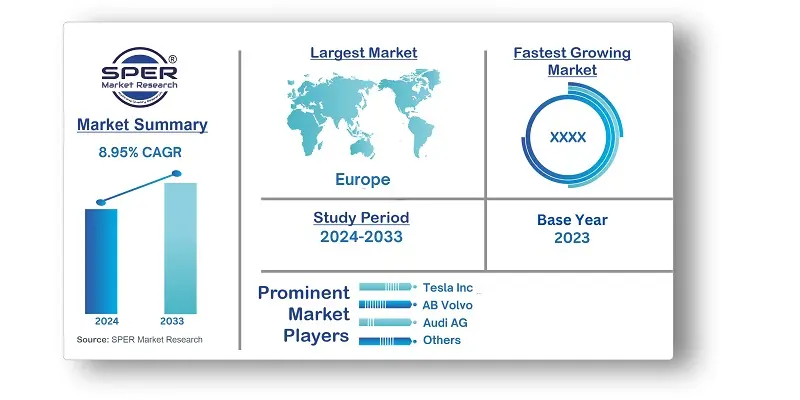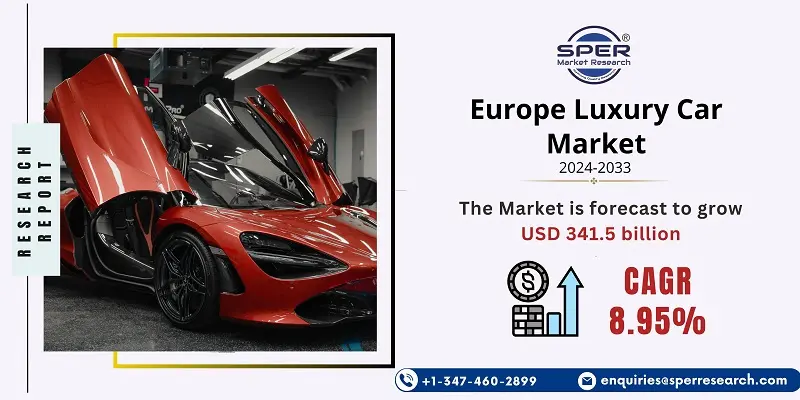
Europe Luxury Car Market Growth, Size, Trends, Demand, Share, Revenue and Future Outlook
Europe Luxury Car Market Size- By Vehicle Type, By Drive Type- Regional Outlook, Competitive Strategies and Segment Forecast to 2033
| Published: Jul-2024 | Report ID: AMIN24158 | Pages: 1 - 151 | Formats*: |
| Category : Automotive & Transportation | |||
- September 2022: MG Motor launches the MG4 EV in Europe. The MG4 electric is powered by a 51-kWh lithium-ion battery and has a range of up to 350 kilometres.
- In June 2022, Audi announced plans to extend its urban fast charging points in the United Kingdom for luxury EV categories. The company previously opened the first semi-permanent charging infrastructure in Nuremberg, Germany, with six 320kW fast chargers and a lounge.
- May 2022: Lucid group, an electric car manufacturer, announced plans to deliver a luxury sedan in Europe by the end of 2022. Lucid Air Dream Edition P and R sedans will be available in limited quantities to consumers in Germany, Switzerland, the Netherlands, and Norway in late 2022.


| Report Metric | Details |
| Market size available for years | 2020-2033 |
| Base year considered | 2023 |
| Forecast period | 2024-2033 |
| Segments covered | By Vehicle Type, By Drive Type |
| Regions covered | Germany, France, Italy, UK, Russia, and the Rest of Europe. |
| Companies Covered | Tesla Inc, AB Volvo, Audi AG, BMW AG, Ford Motor Company, Fiat Chrysler Automobiles, Meredes-Benz Group AG, Hyundai Motor Company, Rolls-Royce Holding PLC, Bentley Motors. |
- High-Net-Worth Individuals (HNWIs)
- Upper-Middle-Class Professionals
- Corporate Executives
- Car Enthusiasts and Collectors
- Celebrities and Influencers
- Tourists and Expatriates
- Lease and Rental Companies
| By Vehicle Type: |
|
| By Drive Type: |
|
- Europe Luxury Car Market Size (FY’2024-FY’2033)
- Overview of Europe Luxury Car Market
- Segmentation of Europe Luxury Car Market By Vehicle Type (Hatchback, Sedan, Sport Utility Vehicle, Multi-purpose Vehicle)
- Segmentation of Europe Luxury Car Market By Drive Type (IC Engine, Electric)
- Statistical Snap of Europe Luxury Car Market
- Expansion Analysis of Europe Luxury Car Market
- Problems and Obstacles in Europe Luxury Car Market
- Competitive Landscape in the Europe Luxury Car Market
- Impact of COVID-19 and Demonetization on Europe Luxury Car Market
- Details on Current Investment in Europe Luxury Car Market
- Competitive Analysis of Europe Luxury Car Market
- Prominent Players in the Europe Luxury Car Market
- SWOT Analysis of Europe Luxury Car Market
- Europe Luxury Car Market Future Outlook and Projections (FY’2024-FY’2033)
- Recommendations from Analyst
1.1. Scope of the report1.2. Market segment analysis
2.1. Research data source2.1.1. Secondary Data2.1.2. Primary Data2.1.3. SPER’s internal database2.1.4. Premium insight from KOL’s2.2. Market size estimation2.2.1. Top-down and Bottom-up approach2.3. Data triangulation
4.1. Driver, Restraint, Opportunity and Challenges analysis4.1.1. Drivers4.1.2. Restraints4.1.3. Opportunities4.1.4. Challenges4.2. COVID-19 Impacts of the Europe Luxury Car Market
5.1. SWOT Analysis5.1.1. Strengths5.1.2. Weaknesses5.1.3. Opportunities5.1.4. Threats5.2. PESTEL Analysis5.2.1. Political Landscape5.2.2. Economic Landscape5.2.3. Social Landscape5.2.4. Technological Landscape5.2.5. Environmental Landscape5.2.6. Legal Landscape5.3. PORTER’s Five Forces5.3.1. Bargaining power of suppliers5.3.2. Bargaining power of buyers5.3.3. Threat of Substitute5.3.4. Threat of new entrant5.3.5. Competitive rivalry5.4. Heat Map Analysis
6.1. Europe Luxury Car Market Manufacturing Base Distribution, Sales Area, Product Type6.2. Mergers & Acquisitions, Partnerships, Product Launch, and Collaboration in Europe Luxury Car Market
7.1. Europe Luxury Car Market Size, Share and Forecast, By Vehicle Type, 2020-20267.2. Europe Luxury Car Market Size, Share and Forecast, By Vehicle Type, 2027-20337.3. Hatchback7.4. Sedan7.5. Sport Utility Vehicle7.6. Multi-purpose Vehicle
8.1. Europe Luxury Car Market Size, Share and Forecast, By Drive Type, 2020-20268.2. Europe Luxury Car Market Size, Share and Forecast, By Drive Type, 2027-20338.3. IC Engine8.4. Electric
9.1. Europe Luxury Car Market Size and Market Share
10.1. Europe Luxury Car Market Size and Market Share By Region (2020-2026)10.2. Europe Luxury Car Market Size and Market Share By Region (2027-2033)10.3. Germany10.4. France10.5. Italy10.6. UK10.7. Russia10.8. Rest of Europe
11.1. Tesla Inc11.1.1. Company details11.1.2. Financial outlook11.1.3. Product summary11.1.4. Recent developments11.2. AB Volvo11.2.1. Company details11.2.2. Financial outlook11.2.3. Product summary11.2.4. Recent developments11.3. Audi AG11.3.1. Company details11.3.2. Financial outlook11.3.3. Product summary11.3.4. Recent developments11.4. BMW AG11.4.1. Company details11.4.2. Financial outlook11.4.3. Product summary11.4.4. Recent developments11.5. Ford Motor Company11.5.1. Company details11.5.2. Financial outlook11.5.3. Product summary11.5.4. Recent developments11.6. Fiat Chrysler Automobiles11.6.1. Company details11.6.2. Financial outlook11.6.3. Product summary11.6.4. Recent developments11.7. Meredes-Benz Group AG11.7.1. Company details11.7.2. Financial outlook11.7.3. Product summary11.7.4. Recent developments11.8. Hyundai Motor Company11.8.1. Company details11.8.2. Financial outlook11.8.3. Product summary11.8.4. Recent developments11.9. Rolls-Royce Holding PLC11.9.1. Company details11.9.2. Financial outlook11.9.3. Product summary11.9.4. Recent developments11.10. Bentley Motors11.10.1. Company details11.10.2. Financial outlook11.10.3. Product summary11.10.4. Recent developments11.11. Others
SPER Market Research’s methodology uses great emphasis on primary research to ensure that the market intelligence insights are up to date, reliable and accurate. Primary interviews are done with players involved in each phase of a supply chain to analyze the market forecasting. The secondary research method is used to help you fully understand how the future markets and the spending patterns look likes.
The report is based on in-depth qualitative and quantitative analysis of the Product Market. The quantitative analysis involves the application of various projection and sampling techniques. The qualitative analysis involves primary interviews, surveys, and vendor briefings. The data gathered as a result of these processes are validated through experts opinion. Our research methodology entails an ideal mixture of primary and secondary initiatives.



Frequently Asked Questions About This Report
PLACE AN ORDER
Year End Discount
Sample Report
Pre-Purchase Inquiry
NEED CUSTOMIZATION?
Request CustomizationCALL OR EMAIL US
100% Secure Payment






Related Reports
Our Global Clients
Our data-driven insights have influenced the strategy of 200+ reputed companies across the globe.




















